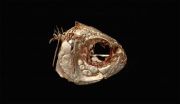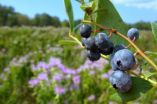(Press-News.org) As fires sweep more frequently across the American Great Basin, the US Bureau of Land Management (BLM) has been tasked with reseeding the burned landscapes to stabilize soils. BLM's interventions have not helped to restore habitat for the greater sage grouse (Centrocercus urophasianus) reported scientists from the US Geological Survey (USGS) and US Forest Service in the Ecological Society of America's journal Ecosphere last week, but outlier project sites with good grouse habitat may yield clues to successful management scenarios.
Their report arrives in the shadow of a pending decision by the US Fish and Wildlife Service (FWS) to protect the sage grouse under the Endangered Species Act, and efforts by BLM and FWS to establish voluntary conservation and restoration management plans in lieu of endangered species listing mandates.
Protection of sage grouse under the Endangered Species Act could affect the management of 250,000 square miles of land in the western US. FWS must decide on the grouse's protection status by the end of FY 2015.
Wildfire is the predominant cause of habitat loss in the Great Basin. The sagebrush ecosystem is not adapted to frequent fires like some forests in California and the central Rockies, and fires have increased in frequency and in size over the last half century.
"The most common species, big sagebrush, doesn't re-sprout from the stump. After it burns, it's dead and it has to reseed, and it's not very good at dispersing seeds long distance," said author Robert Arkle, a supervisory ecologist for the USGS Forest & Rangeland Ecosystem Science Center at the Snake River Field Station in Idaho. "Seeds aren't viable very long. Some years they don't reproduce at all, without the right spring conditions. Getting sage established out in the middle of these big burned areas is a difficult task."
Arkle emphasized that recovery of sage grouse habitat is not part of BLM's wildfire response directive. BLM's Emergency Stabilization and Rehabilitation (ESR) program is designed to reestablish perennial plant cover following wildfire, preventing erosion and limiting the spread of non-native species.
"Accomplishing those goals certainly wouldn't hurt sage grouse, but whether or not these treatments provide a benefit for sage grouse doesn't have bearing on the success of the ESR program," said Arkle. "It's important to recognize the difficulty of what the land management community is trying to do."
Historically, the Great Basin burned in smaller, patchier conflagrations, at intervals on the order of once per century. Managers are now seeing sagebrush country burn every 20 years in parts of the Great Basin, fueled by drought and vigorous non-natives like cheatgrass (Bromus tectorum).
"Almost a million acres burn each year in the Great Basin and, since 1990, about 6% of the Great Basin has been treated with these ESR projects. Almost all treated acres occur in historic sage grouse habitat," said Arkle. That's why the team chose to look at ESR project sites. "We have this problem with non-native plants coming in, changing the fire cycle, and promoting more frequent fires. We wanted to know if ESR treatments had improved conditions for grouse in these vast burned areas."
The average ESR project encompasses 4 square miles. In 2007, the Murphy Complex Fire burned 653,000 square miles in south-central Idaho. To cover such large areas, BLM spreads seed from aircraft or with tractor and rangeland drill seeders, usually in the fall or early winter. They customize a mix of forb, bunchgrass, and shrub seeds to the site. In recent years, BLM has moved to using native species when possible.
Arkle and colleagues examined 101 sites that burned once between 1990 and 2003. To select their sites, they compiled a database of fires and ESR projects from which they randomly chose a set of project sites with a gradient of precipitation and annual temperatures but similar soil types.
"Treated plots were not much more likely to be used by sage grouse than the burned and untreated, on average, but there were outliers. Those are important, because they are sites where the treatments were more effective, in terms of sage grouse habitat," said Arkle.
Sage grouse prefer land that has not burned at all in recent decades. Arkle and his colleagues found little sagebrush cover at burned sites, whether treated or not.
"I think that's the most important finding, because some sites burned 20 years ago and still haven't recovered," said Arkle. "We did not see a trend of increasing sagebrush cover with time, so time is not the limiting factor in this 20 year window." If not time, then what does sagebrush need to recover? The limiting factor could be related to climate, or prevalence of non-native plants. It is a question the researchers hope to address in the future.
Sage grouse are picky birds, Arkle and colleagues found, preferring a sagebrush steppe environment featuring very little human development and dwarf sagebrush (Artemisia arbuscula, A. nova, or A. tripartite) but not cheatgrass or other non-native plants. Even in otherwise primo landscapes, if just 2.5% of the land is developed within five kilometers of a site, the birds will be half as likely to use it. If any development, including paved roads, can be seen, they don't want be there. Seemingly low impact structures like fences and livestock watering stations provide predatory ravens with high perches from which to spy sage grouse nests.
The outlier ESR sites preferred by sage grouse had healthier sagebrush and shared common climate and post-treatment weather conditions. Sagebrush recovery fared better in more northerly, higher elevation sites, with relatively cool, moist springs. Spring weather has big role in successful germination and growth of sagebrush during the crucial first growing season. Sagebrush biology and physiology can be the biggest hurdle for restoration managers.
To Arkle's mind, the study results argue for maintaining and protecting existing expanses of intact, high quality habitat, and only secondarily trying to fix what's broken.
Experimental techniques have some promise, and include multiple seedings when the first try fails, out-planting pods of seedlings, and using different types of drill seeding equipment. Reseeding burns with local varietals or close genetic matches could improve recruitment. Controlling non-native plants with herbicides and fungal infections has been tried, with mixed results.
But the factors that ultimately determine the survival of the sagebrush ecosystem may be out of managers' control. The study, and another tracking the recovery of mountain big sagebrush (A. tridentate subsp. vaseyana) at high elevation, suggest that climate may play a role in the failure of big sage germination and establishment in hotter locations. Managers can try to work with and around climate and weather constraints, but impending climate changes will likely make this task more difficult. Some sites are more resilient than others. It's possible that parts of the Great Basin will cross a tipping point of climate and species representation, from which they cannot return.
"There is potential for sites to move into a new plant community state," said Arkle. "It's possible that some have gone past a threshold. We could have a really difficult time trying to move them back to plant communities that existed historically."
INFORMATION:
Robert S. Arkle, David S. Pilliod, Steven E. Hanser, Matthew L. Brooks, Jeanne C. Chambers, James B. Grace, Kevin C. Knutson, David A. Pyke, Justin L. Welty, and Troy A. Wirth 2014. Quantifying restoration effectiveness using multi-scale habitat models: implications for sage-grouse in the Great Basin. Ecosphere 5:art31. http://dx.doi.org/10.1890/ES13-00278.1
The Ecological Society of America is the world's largest community of professional ecologists and a trusted source of ecological knowledge. ESA is committed to advancing the understanding of life on Earth. The 10,000 member Society publishes five journals, convenes an annual scientific conference, and broadly shares ecological information through policy and media outreach and education initiatives. Visit the ESA website at http://www.esa.org.
To subscribe to ESA press releases, contact Liza Lester at llester@esa.org.
Sage grouse losing habitat to fire as endangered species decision looms
Post-wildfire stabilization treatment has not aided habitat restoration for the imperiled Great Plains birds
2014-04-03
ELSE PRESS RELEASES FROM THIS DATE:
Examination of a cave-dwelling fish finds a possible genetic link to human disorders
2014-04-03
Researchers have identified a genetic association with facial asymmetry in an ancient cavefish, a natural trait that may solve mysteries surrounding facial asymmetries in humans – conditions such as cleft palate or hemifacial microsomia. This exciting discovery by Joshua Gross, a University of Cincinnati assistant professor for the Department of Biological Sciences; and doctoral students Amanda Krutzler and Brian Carlson, is published in the research journal, Genetics.
The researchers are studying the craniofacial features of the eyeless, cave-dwelling fish, Astyanax ...
Synergy of high protein intake and exercise in youth enhances bone structure and strength
2014-04-03
A study presented during the World Congress on Osteoporosis, Osteoarthritis and Musculoskeletal Diseases in Seville shows that high levels of protein intake (HProt) enhance the positive impact of high physical activity (HPA) on bone structure and strength in healthy pre-pubertal boys.
Researchers from the University of Geneva in Switzerland and Eindhoven University in the Netherlands tracked 176 healthy pre-pubertal boys (average age 7.4 years) to mid-adolescence (average age 15.2 years). Compared to moderate protein intake, HProt in combination with HPA was associated ...
Adults' tonsillectomy complications are higher than previously thought
2014-04-03
Twenty percent of adults who have tonsillectomies will have a complication, which is significantly higher than previously shown, according to a team of researchers. The team also found that these complications substantially increase health care expenditures.
"Since 1973, John Wenneberg and his colleagues at Dartmouth have been examining variation in the rates of tonsillectomy performed across regions, trying to explain why such wide variation is observed," said Dennis Scanlon, professor of health policy and administration, Penn State. "In other words, why are some patients ...
Report documents cardiopulmonary arrest in premature infant after cyclomydril eyedrops
2014-04-03
San Francisco, CA, April 2, 2014 – Eyedrops administered to infants as part of routine outpatient retinopathy of prematurity (ROP) screening can have life-threatening consequences. A case report published in the current issue of the Journal of the American Association for Pediatric Ophthalmology and Strabismus (AAPOS) describes cardiopulmonary arrest in a 27-week-old infant following administration of three sets of cyclopentolate 0.2%/phenylephrine 1% (Cyclomydril) eyedrops.
"Cardiopulmonary arrest can occur from just instillation of eyedrops in a premature infant seen ...
Drawing conclusions
2014-04-03
Is a picture worth only a thousand words? According to Dr. Carmit Katz of Tel Aviv University's Bob Shapell School of Social Work, illustrations by children can be a critical tool in forensic investigations of child abuse.
Dr. Katz's study, published in Child Abuse and Neglect, compared the results when child abuse victims were offered the opportunity to draw during questioning with victims not offered this opportunity. Her findings saw a significant difference, suggesting a therapeutic value and indicating that children empowered to draw pictures about their abuse provided ...
Radium-223 dichloride in prostate cancer: Major added benefit for certain patients
2014-04-03
Radium-223 dichloride (radium-223 for short, trade name: Xofigo) has been approved since November 2013 for men with advanced prostate cancer, in whom hormone blockade is no longer effective, and symptomatic bone metastases, but without visceral metastases. In an early benefit assessment pursuant to the Act on the Reform of the Market for Medicinal Products (AMNOG), the German Institute for Quality and Efficiency in Health Care (IQWiG) examined whether this new drug offers an added benefit over the appropriate comparator therapy specified by the Federal Joint Committee (G-BA).
No ...
Nanoparticles cause cancer cells to self-destruct
2014-04-03
Using magnetically controlled nanoparticles to force tumour cells to 'self-destruct' sounds like science fiction, but could be a future part of cancer treatment, according to research from Lund University in Sweden.
Watch video:https://www.youtube.com/watch?v=vos0QW2Yclk&feature=youtu.be
"The clever thing about the technique is that we can target selected cells without harming surrounding tissue. There are many ways to kill cells, but this method is contained and remote-controlled", said Professor Erik Renström.
The point of the new technique is that it is much more ...
Tiny power generator runs on spit
2014-04-03
Saliva-powered micro-sized microbial fuel cells can produce minute amounts of energy sufficient to run on-chip applications, according to an international team of engineers.
Bruce E. Logan, Evan Pugh Professor and Kappe Professor of Environmental Engineering, Penn State, credited the idea to fellow researcher Justine E. Mink. "The idea was Justine's because she was thinking about sensors for such things as glucose monitoring for diabetics and she wondered if a mini microbial fuel cell could be used," Logan said. "There is a lot of organic stuff in saliva."
Microbial ...
Attracting wild bees to farms is a good insurance policy
2014-04-03
EAST LANSING, Mich. -- Investing in habitat that attracts and supports wild bees in farms is not only an effective approach to helping enhance crop pollination, but it can also pay for itself in four years or less, according to Michigan State University research.
The paper, published in the current issue of the Journal of Applied Ecology, gives farmers of pollination-dependent crops tangible results to convert marginal acreage to fields of wildflowers, said Rufus Isaacs, MSU entomologist and co-author of the paper.
"Other studies have demonstrated that creating flowering ...
Pulmonary hypertension deaths have increased over past decade according to CDC report in CHEST
2014-04-03
Deaths from pulmonary hypertension have increased over the past decade, according to a study from the Centers for Disease Control and Prevention (CDC).
In the study, published online in CHEST, researchers analyzed death rates from the National Vital Statistics System and data from the National Hospital Discharge Survey between 2001 and 2010 to analyze trends in hospitalizations and death rates related to pulmonary hypertension.
Pulmonary hypertension is characterized by increased blood pressure in the pulmonary arteries, causing the right side of the heart to work ...
LAST 30 PRESS RELEASES:
Numbers in our sights affect how we perceive space
SIMJ announces global collaborative book project in commemoration of its 75th anniversary
Air pollution exposure and birth weight
Obstructive sleep apnea risk and mental health conditions among older adults
How talking slows eye movements behind the wheel
The Ceramic Society of Japan’s Oxoate Ceramics Research Association launches new international book project
Heart-brain connection: international study reveals the role of the vagus nerve in keeping the heart young
Researchers identify Rb1 as a predictive biomarker for a new therapeutic strategy in some breast cancers
Survey reveals ethical gaps slowing AI adoption in pediatric surgery
Stimulant ADHD medications work differently than thought
AI overestimates how smart people are, according to HSE economists
HSE researchers create genome-wide map of quadruplexes
Scientists boost cell "powerhouses" to burn more calories
Automatic label checking: The missing step in making reliable medical AI
Low daily alcohol intake linked to 50% heightened mouth cancer risk in India
American Meteorological Society announces Rick Spinrad as 2026 President-Elect
Biomass-based carbon capture spotlighted in newly released global climate webinar recording
Illuminating invisible nano pollutants: advanced bioimaging tracks the full journey of emerging nanoscale contaminants in living systems
How does age affect recovery from spinal cord injury?
Novel AI tool offers prognosis for patients with head and neck cancer
Fathers’ microplastic exposure tied to their children’s metabolic problems
Research validates laboratory model for studying high-grade serous ovarian cancer
SIR 2026 delivers transformative breakthroughs in minimally invasive medicine to improve patient care
Stem Cell Reports most downloaded papers of 2025 highlight the breadth and impact of stem cell research
Oxford-led study estimates NHS spends around 3% of its primary and secondary care budget on the health impacts of heat and cold in England
A researcher’s long quest leads to a smart composite breakthrough
Urban wild bees act as “microbial sensors” of city health.
New study finds where you live affects recovery after a hip fracture
Forecasting the impact of fully automated vehicle adoption on US road traffic injuries
Alcohol-related hospitalizations from 2016 to 2022
[Press-News.org] Sage grouse losing habitat to fire as endangered species decision loomsPost-wildfire stabilization treatment has not aided habitat restoration for the imperiled Great Plains birds



